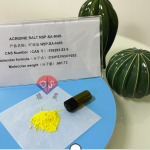Chinese VersionChina Suppliers > Hubei new DE sheng material science and technology co., LTD. > Do chemiluminescent reagents NSP-SA-NHS need to be refrigerated
- Search Product
-
-
- Region :China/Hubei
- Tel : +86-18971041571
- Fax :
- Email :vickyzhao@whdschem.com
- URL :
- Add :Guanggu United Science and Technology City C8, Ezhou City, Hubei Province
- Details for Do chemiluminescent reagents NSP-SA-NHS need to be refrigerated
-
Do chemiluminescent reagents NSP-SA-NHS need to be refrigerated 199293-83-9
Category : Other Chemicals

CAS NO : 199293-83-9 EC NO : MF : MW : Specification : yellow powder. Packing : 10g/bottle Product description : Chemiluminescence reagent NSP-SA-NHS is a yellow solid or powder with a purity higher than 98%, CAS number 199293-83-9, which can be used for labeling proteins, antigens, antibodies, nucleic acids (DNA, RNA), etc. It has the characteristics of good water solubility, stable process, and small inter batch differences. Related compounds have been proven to be highly advantageous chemiluminescent markers, with stability, activity, and sensitivity surpassing those of radioactive isotopes. Before exploring storage methods, we first need to understand the basic characteristics of acridine salt NSP-SA-NHS. This type of reagent usually has good chemical stability and photostability, and can maintain activity for a long time at room temperature. However, its stability is also affected by some factors, such as temperature, light, humidity, etc. Therefore, the correct storage method is crucial for maintaining the activity of reagents. Although acridine salt NSP-SA-NHS has certain stability at room temperature, refrigerated storage can further extend its service life. Low temperature environment can slow down the rate of chemical reactions, reduce the decomposition rate of reagents, and thus maintain their activity and stability. In addition, refrigeration can reduce the risk of microbial contamination and ensure the purity and quality of reagents. Of course, refrigerated storage does not mean simply putting the reagents in the refrigerator. Firstly, it is necessary to choose an appropriate refrigeration temperature, usually 4 ℃ or lower, to avoid reagent deactivation caused by excessive temperature. Secondly, it is important to ensure that the reagents are not exposed to light during storage, as light may cause decomposition or denaturation of the reagents. Finally, it is important to avoid the reagents being affected by vibrations or moisture in the refrigerator to prevent packaging damage or moisture. Due to the fact that acridine salt NSP-SA-NHS is an expensive chemiluminescent reagent, special attention should be paid during storage and transportation. In addition to controlling storage temperature, brown glass or plastic bottles will also be used for packaging to avoid direct sunlight. In addition, the packaging of acridine salt NSP-SA-NHS is 1g/bottle, 5g/bottle, 10g/bottle, etc. This can accurately add the corresponding amount according to the usage needs, and try to avoid long-term contact between the reagent and air, which may cause clumping, deterioration, deactivation, etc. Therefore, it is also important to seal the reagent when it is not in use. Uses : Chemiluminescence reagent Synonyms : NSP-AS;
- Inquire
-
Do chemiluminescent reagents NSP-SA-NHS need to be refrigerated